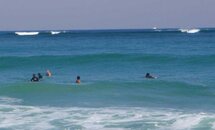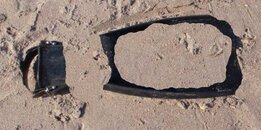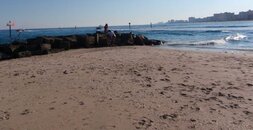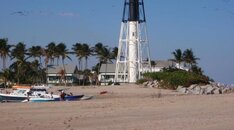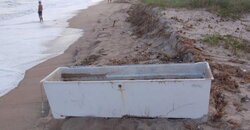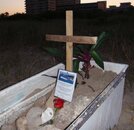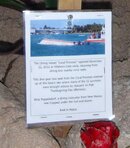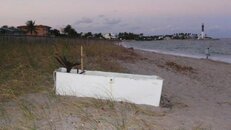You are using an out of date browser. It may not display this or other websites correctly.
You should upgrade or use an alternative browser.
You should upgrade or use an alternative browser.
Boat capsized in pompano beach?
- Thread starter deepstops
- Start date
Please register or login
Welcome to ScubaBoard, the world's largest scuba diving community. Registration is not required to read the forums, but we encourage you to join. Joining has its benefits and enables you to participate in the discussions.
Benefits of registering include
- Ability to post and comment on topics and discussions.
- A Free photo gallery to share your dive photos with the world.
- You can make this box go away
- Messages
- 19,763
- Reaction score
- 18,617
- Location
- Philadelphia and Boynton Beach
- # of dives
- 1000 - 2499
Not knowing all that much about boats and their operation, I do the best I can to stay safe, I go out with Kevin and Alex, Underwater Explorers, see #67
This thread is very related to the "Boat capsized in pompano beach?" thread so I thought I'd put it close by it. I think it's about how an event like this touches us and makes us wonder.
Thursday I was kayaking out to the inlet and arrived maybe an hour after the accident, and started taking photos and video clips of the waves and the flipped over hull as she was towed back through the pass. Fascinated and impressed by Seatow's salvage skills in these adverse conditions, I followed all the way to Hidden Harbor Marina where they flipped her back over.
That first day all I found were floating packages of cheese crackers. The dive boat always had boxes of them aboard. I took more pics & vids of the surfers before sundown. For three days there were awesome wave sets breaking a half mile offshore all along the Pompano Drop-off. (pic.)
Next I found the fin. It's a classic vented powerfin and not the kind some snorkeler would lose on the huge new inlet sandbar. (next pics.) I'm sure it came from the Princess and I hope somebody has the mate and calls me to ID it. It would be great to return it.
I've dove on the Coral Princess many times and her sistership Aquaview as well. I like all the people at South Florida Diving. It gave me a funny feeling to find some torn pieces of the sunbrella top scattered along the beach. Friday I found the badly broken long seat/gear box from the Coral Princess where it washed ashore, (see pic) and also where many of the 22 survivors were brought to land by rescuers. I didn't know Nina Poppelsdorf but she was a diving instructor like me, and even though I had no clue what to do with it, I wanted to do something. Late today I pushed it up to a close dune and filled it with sand and coral rocks. That should keep it from going anywhere. Next I attached the wreck photo and a brief story to a cross, then a plant and a rose. It pales to the Copenhagen but Pompano Beach now has one more shipwreck memorial. Pics.
Funny thing... while I was finishing a tourist asked if there was a body in there! WTF? To me it's clearly a boat seat gear box, but after stepping back it does look a little coffin-like. I'll add a few dive flag stickers and some more colorful plants to make it a little less goulish.
If you're out by the 16th St N Ocean Park, it's about 75 yards to the north by the two benches.
Chad
Thursday I was kayaking out to the inlet and arrived maybe an hour after the accident, and started taking photos and video clips of the waves and the flipped over hull as she was towed back through the pass. Fascinated and impressed by Seatow's salvage skills in these adverse conditions, I followed all the way to Hidden Harbor Marina where they flipped her back over.
That first day all I found were floating packages of cheese crackers. The dive boat always had boxes of them aboard. I took more pics & vids of the surfers before sundown. For three days there were awesome wave sets breaking a half mile offshore all along the Pompano Drop-off. (pic.)
Next I found the fin. It's a classic vented powerfin and not the kind some snorkeler would lose on the huge new inlet sandbar. (next pics.) I'm sure it came from the Princess and I hope somebody has the mate and calls me to ID it. It would be great to return it.
I've dove on the Coral Princess many times and her sistership Aquaview as well. I like all the people at South Florida Diving. It gave me a funny feeling to find some torn pieces of the sunbrella top scattered along the beach. Friday I found the badly broken long seat/gear box from the Coral Princess where it washed ashore, (see pic) and also where many of the 22 survivors were brought to land by rescuers. I didn't know Nina Poppelsdorf but she was a diving instructor like me, and even though I had no clue what to do with it, I wanted to do something. Late today I pushed it up to a close dune and filled it with sand and coral rocks. That should keep it from going anywhere. Next I attached the wreck photo and a brief story to a cross, then a plant and a rose. It pales to the Copenhagen but Pompano Beach now has one more shipwreck memorial. Pics.
Funny thing... while I was finishing a tourist asked if there was a body in there! WTF? To me it's clearly a boat seat gear box, but after stepping back it does look a little coffin-like. I'll add a few dive flag stickers and some more colorful plants to make it a little less goulish.
If you're out by the 16th St N Ocean Park, it's about 75 yards to the north by the two benches.
Chad
Attachments
Thanks for some great information especially Scubakevdm Lots to think about and learn here. Tragic price to pay but hopefully some good will come of it that will keep people safer in the future.
- Messages
- 5,884
- Reaction score
- 2,997
- Location
- Lake Worth, Florida, United States
- # of dives
- I'm a Fish!
I used to have a 34 foot Regal, a "booze cruiser" I modified for diving with friends....I used to use the Boynton Inlet freqeuntly when I kept the boat in Lantana at Loggerhead, so when I first got the boat, I began practicing going in and out of the Boynton Inlet in small, then medium, the large, then storm sized waves....I had good advice from some of the best dive boat Captains on what to do, and reading the "sets" became second nature....For my boat, the really imposible condition is the going OUT of the Boynton Inlet if the waves are too big, because it would stand my boat up, and the props could hit bottom in the shallow water you have to traverse. Going in, you have learned to surf...first in medium waves, then larger, and the skill is not so hard...the real issue coming in with large waves, is whether the boat is powered sufficiently for big waves....Mine could hit 30mph , and it could take off pretty fast....so I would read the sets, pick a big wave, and catch up to and stay on top of a big wave( the back half) all the way into the inlet. Your hand stays on the throttle, and you constantly change throttle as the wave speed dictates...you have to be able to slow down, or INSTANTLY speed up if needed, and there is often a point right where you enter and turn in to the inlet, where you really need to gas it....I have seen underpowered boats hit this area and almost lose it here. With mine, I always had way more power and instant speed than needed. If I had 12 people on my boat( would have been overloaded for my particular boat), then my boat would have responded slower to the throttle, and my margin for emergency speed increases would suffer.
What I learned from all this, is that if I am on a charter boat anywhere in the world, and we are approaching an inlet, and I see wave structures I know will require the captain to time the entrance, and use special skills for....depending on how bad the conditions are, my buddy and I will prepare ourselves for a bad entry....If it was insanely bad looking, I would have fins mask and snorkel on. If it was just nasty, I would still have my gear close to me so I could grab it....In fact, I have been in one situation, one time, where I and buddy DID put our fins, masks and snorkels on---fortunately they were not needed.
Even though we are passengers, we do not need to be helpless...If you get yourself ready for it, there is pretty much nothing that you can't handle. There is certainly no inlet condition that a freediver could not swim through.....and that is what the passengers should be thinking if the entry looks like the boat may have trouble....
This is not taught or discussed in a dive class that I have ever heard of, but it is worthwhile for all divers to realize, and have in their back pocket for any time the weather creates " the perfect storm" in the boat's return through an inlet.
It's even another reason why everyone should do at least a few days of snorkeling in the surf zone at the beach, to figure out the easy way to swim in with waves....Hint....you dive down under them, you don't try to body surf them!
What I learned from all this, is that if I am on a charter boat anywhere in the world, and we are approaching an inlet, and I see wave structures I know will require the captain to time the entrance, and use special skills for....depending on how bad the conditions are, my buddy and I will prepare ourselves for a bad entry....If it was insanely bad looking, I would have fins mask and snorkel on. If it was just nasty, I would still have my gear close to me so I could grab it....In fact, I have been in one situation, one time, where I and buddy DID put our fins, masks and snorkels on---fortunately they were not needed.
Even though we are passengers, we do not need to be helpless...If you get yourself ready for it, there is pretty much nothing that you can't handle. There is certainly no inlet condition that a freediver could not swim through.....and that is what the passengers should be thinking if the entry looks like the boat may have trouble....
This is not taught or discussed in a dive class that I have ever heard of, but it is worthwhile for all divers to realize, and have in their back pocket for any time the weather creates " the perfect storm" in the boat's return through an inlet.
It's even another reason why everyone should do at least a few days of snorkeling in the surf zone at the beach, to figure out the easy way to swim in with waves....Hint....you dive down under them, you don't try to body surf them!
skimon
Registered
What I learned from all this, is that if I am on a charter boat anywhere in the world, and we are approaching an inlet, and I see wave structures I know will require the captain to time the entrance, and use special skills for....depending on how bad the conditions are, my buddy and I will prepare ourselves for a bad entry....If it was insanely bad looking, I would have fins mask and snorkel on. If it was just nasty, I would still have my gear close to me so I could grab it....In fact, I have been in one situation, one time, where I and buddy DID put our fins, masks and snorkels on---fortunately they were not needed.
Even though we are passengers, we do not need to be helpless...If you get yourself ready for it, there is pretty much nothing that you can't handle. There is certainly no inlet condition that a freediver could not swim through.....and that is what the passengers should be thinking if the entry looks like the boat may have trouble....
This is not taught or discussed in a dive class that I have ever heard of, but it is worthwhile for all divers to realize, and have in their back pocket for any time the weather creates " the perfect storm" in the boat's return through an inlet.
It's even another reason why everyone should do at least a few days of snorkeling in the surf zone at the beach, to figure out the easy way to swim in with waves....Hint....you dive down under them, you don't try to body surf them!
Very interesting information - thanks for sharing. In reading the posts on this tragic incident, I wondered what one should do if faced with a similar situation and I thought of donning a PFD (life jacket) before the boat attempted to transit the inlet in case the worst case scenario occurred. The PFD would help if you were dazed or somewhat incapacitated when the boat flipped and would help you stay afloat while awaiting arrival of rescue boats.
- Messages
- 5,884
- Reaction score
- 2,997
- Location
- Lake Worth, Florida, United States
- # of dives
- I'm a Fish!
Certainly each person needs to figure out what is best for them...if you move quickly and easily in a high stress environment ( a boat about to tip) then a pfd could be a problem, if you find it desirable to go underwater --whether to avoid some part of the boat, to get out from under it, or to get under a huge breaking wave. This is why I would be geared up as if I was freediving--including weight belt to have me neutral in the water. I would refuse the pfd, but that is me....each person would need to think through how they would handle the pitching and everything else.Very interesting information - thanks for sharing. In reading the posts on this tragic incident, I wondered what one should do if faced with a similar situation and I thought of donning a PFD (life jacket) before the boat attempted to transit the inlet in case the worst case scenario occurred. The PFD would help if you were dazed or somewhat incapacitated when the boat flipped and would help you stay afloat while awaiting arrival of rescue boats.
I am sure the Coast Guard would want the PFD on you, but that is pretty irrelevant to me.
Wookie
Proud to be a Chaos Muppet
Staff member
ScubaBoard Business Sponsor
ScubaBoard Supporter
Scuba Instructor
Some inspected vessels must post written instructions to the captain when crossing hazardous bars, and those instructions include having all personnel don life preservers. I am not sure which inspected vessels must post these instructions, mine is one of them.
- Messages
- 53,669
- Reaction score
- 7,849
- # of dives
- 500 - 999
Wearing life vests on moving boats would certainly lead to fewer fatalities overall altho there is a risk of being trapped under a capsized boat and unable to swim lower because of buoyancy. It seems most boaters and divers just don't appreciate them tho as I don't think I have ever seen anyone else wear one. I wear a snorkel vest on any moving boat, more so than I used to, and let them laugh. Years ago a Roatan charter tried to take us on a channel crossing to Utila with no vests or extinguishers on board. I grabbed a couple of vests before boarding, altho no one else seemed concerned, and learned about the lack of extinguishers later when they called for a transmission fluid delivery. We never got away from Roatan.
Has there been a rash of capsizings lately? One guy spent 7 hours clinging to a cooler lid in Biscayne Bay this weekend: Coast Guard Rescues Man In Biscayne Bay After Boat Capsizes « CBS Miami
These two guys got swamped by a stern wave near Ft.Pierce. AOL.com Video - Fisherman Who Rescued 2 Others: 'Just Another Day at the Office' Between the two of them, they could only grab one small float...
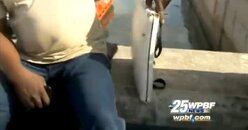
Has there been a rash of capsizings lately? One guy spent 7 hours clinging to a cooler lid in Biscayne Bay this weekend: Coast Guard Rescues Man In Biscayne Bay After Boat Capsizes « CBS Miami
These two guys got swamped by a stern wave near Ft.Pierce. AOL.com Video - Fisherman Who Rescued 2 Others: 'Just Another Day at the Office' Between the two of them, they could only grab one small float...

dumpsterDiver
Banned
- Messages
- 9,003
- Reaction score
- 4,652
- # of dives
- 2500 - 4999
Some inspected vessels must post written instructions to the captain when crossing hazardous bars, and those instructions include having all personnel don life preservers. I am not sure which inspected vessels must post these instructions, mine is one of them.
I was wondering when someone would mention that. Are captains expected to follow up on those instructions and actively direct their passengers to don pfd's prior to attempting to cross the shallow bar/inlet mouth when the conditions are dangerous?
Similar threads
- Replies
- 37
- Views
- 3,803
- Replies
- 12
- Views
- 2,050
- Replies
- 22
- Views
- 2,587




